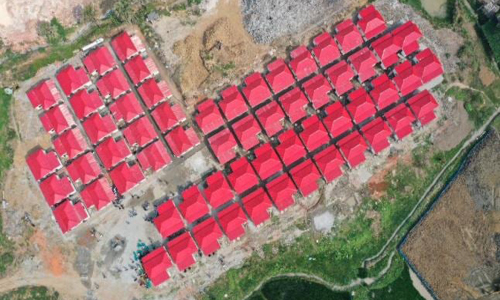
With the aim of inclusive development, cent percent landless-homeless families of 334 upazilas in 21 districts have been rehabilitated in the country under the Ashrayan project.
A total of 5, 55, 617 landless-homeless families were rehabilitated under this project from 1997 to July 2023, said Asharyan-2 project director Abu Saleh Mohammad Ferdous Khan.
Of them, 47, 210 families were resettled in the first phase from 1997 to 2002, 58, 703 families were resettled until the Ashrayan Project (Phase-2: 2002-2010), and 54, 660 families were resettled the Ashrayan-2 Project (2010- 2022 June). They were rehabilitated on government and acquired land by constructing barrack houses.
Besides, 1, 53, 853 families who don’t have house but land were given houses by constructing those on their own land. Some 640 flats built in a multi-storied building in Khurushkul, Cox’s Bazar were handed over free to climate refugee families, 600 specially designed houses for minority groups, 100 families affected by river erosion and 1000 families affected by Cyclone Amphan have been rehabilitated.
On the occasion of Mujib Barsho, in order to implement the directive of Prime Minister Sheikh Hasina that “None of Bangladesh will remain homeless”, the programme to construct of semi-pucca single houses was undertaken to ensure the accommodation of all the landless and homeless people of the country through the Ashrayan project.
The goal of providing semi-pucca houses with land to all the landless and homeless people of the entire country was set in Mujib Barsho. As per the goal, two-room single houses were constructed for 2, 37, 707 landless-homeless-distressed families, 1,073 semi-pucca single houses were built after renovating old dilapidated barracks and 71 houses were built for rehabilitation of disabled families till FY 2022-23.
Project Director Abu Saleh Mohammad Ferdous Khan told BSS that for the implementation of these activities, the guidelines for the implementation of the Ashrayan 2 project and the housing policy 2020 for all the landless and homeless people of the country have been formulated on the occasion of Mujib Centenary.
Beneficiaries are selected in line with that. Apart from this, various committees have been formed at upazila, district and central level in coordination of different agencies for proper guidelines, providing suggestions, supervision, monitoring and inspection to implement the project properly.
He said that Sheikh Hasina’s government has taken various activities to bring the underprivileged people of the society to the mainstream of development through this project. Besides, initiatives have also been taken to provide houses along with land to the backward communities of the society including climate refugees, minorities, third gender, beggars, Bedes, Dalits, Bagdis and Harijans.
Each house has become the main tool for overall well being of a family as well as social development. This new method of inclusive development and poverty alleviation has been recognized globally as the ‘Sheikh Hasina Model’.
In this continuation of inclusive development, all upazilas in 21 districts including Madaripur, Gazipur, Narsingdi, Manikganj and Rajbari of Dhaka Division; Mymensingh and Sherpur of Mymensingh Division; Panchagarh, Dinajpur and Thakurgaon of Rangpur Division; Naogaon, Joypurhat, Rajshahi, Natore, Pabna and Chapainawabganj of Rajshahi Division; Chuadanga, Magura and Kushtia of Khulna division and Pirojpur and Jhalokathi of Barishal district have been completely freed from landless and homeless.
After achieving independence in 1971, Father of the Nation Bangabandhu Sheikh Mujibur Rahman took the initiative, first of its kind, to rehabilitate the landless, homeless, distressed and helpless people of the country.
On February 20 in 1972, Bangabandhu Sheikh Mujibur Rahman visited Charporagacha village in Ramgati Upazila of Lakshmipur district, (the then greater Noakhali district) and ordered for the rehabilitation of landless-homeless-destitute people. It was under his instructions that the rehabilitation of the landless, homeless, destitute poor people of independent Bangladesh began.
After 21 long years of Bangabandhu’s assassination, his daughter Prime Minister Sheikh Hasina got the responsibility of running the country in 1996 and resumed the people-friendly and developmental activities of Bangabandhu. So she took various programs to bring the backward and marginalized people into the mainstream by bringing forward the ‘Inclusive Development Model’, he said.
On May 19 in 1997, a severe cyclone hit Cox’s Bazar and adjacent coastal areas. Prime Minister Sheikh Hasina visited Saint Martin of Teknaf Upazila of Cox’s Bazar district which was hit by cyclone on May 20 in 1997. She had given instruction for taking up necessary steps to rehabilitate the cyclone affected and displaced families.
In view of her guidance, the first rehabilitation work started on the land donated by a local Awami League leader. In continuation of this, a project called ‘Ashrayan’ was taken under the direct supervision of the Prime Minister’s Office in 1997 with the aim of rehabilitating the landless, homeless and distressed families affected by natural disasters such as cyclones, floods and river erosion.
Under this project, 5,55,617 landless and homeless families have been rehabilitated from 1997 to July 2023.
It is the first and largest initiative in history to provide land and houses to the landless and homeless. In order to bring the backward communities of the state into the mainstream, permanent ownership of land is being provided free by constructing houses.
Examples of low-interest loans for land purchase are found in several countries in the world, but the case of providing free land ownership with houses is the first in Bangladesh.